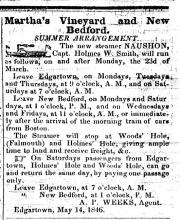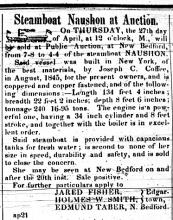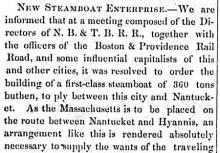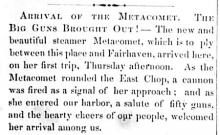The new ferryboat Nantucket, hailing (God save the mark!) from New Bedford, stopped briefly at Vineyard Haven on Tuesday – about an hour and a half – to give the people who are paying half the bill an opportunity to see the new boat. Some of them did, but the view was hardly satisfactory, the time being limited and the boat swarming with children taking advantage of the spring vacation from school.
Skippered by Capt. Joseph Gwodz, the Nantucket came in from Woods Hole and made a very smooth landing, warping around the end of the Vineyard Haven dock and easing into the procedure at Vineyard Haven and Woods Hole, when she goes on the run, in order to be in position to land cars from the bow at Nantucket.
Freight and car accommodations are ample, three aisles fore and aft along her main deck being arranged by the bulkheads which rise from below through which funnels and machinery pass from the engine room. Forty to fifty cars, five to seven of the largest trailer-trucks, and freight in addition, constitute the estimated load for this main deck, with some possible variations depending upon the nature of the freight and size of trailers and dollies.
Entire Stern Opens
The entire stern opens to accommodate the highest trailers allowed on the state highways, and the middle aisle of the tree is crossed at the second deck level by a bridge which may be raised and lowered to admit the high-bodied trucks and facilitate passage across on the deck above by passengers.
Passenger accommodations are more elaborate than has been the case on any other previous boat on the run, the general scheme on the third or principal passenger deck being the alcove and semi-circular form of divan, table and chair combination, bright with red upholstery and chrome. The refreshment var, first aid station, staterooms and lavatories are ample and are efficiently arranged and equipped, on this and the second deck.
Actually there are five decks, counting the engine room level, up to the boat decks, or “hurricane” deck, as it used to be called in the older boats, and here, at the highest point, are the lifeboats, and life-rafts, the latter slung in their patent launching frames from which they can be slid and dropped to the water.
Although identified as a ferry, the Nantucket operates from one end only. Her screws and rudders are at one end, her bridge and wheelhouse at the other. The control bridge is equipped with everything modern and up to date. Her bow opens to permit loading and unloading directly over the stem, and additional ports open slightly forward of the beam on either bow, for side-loading or other handling of cargo. Vehicles also could be handled in this manner by using gangplanks.
Vital Statistics
The description of the boat is as follows: steel built throughout, at the John H. Mathis Shipyard, at Camden, N.J., she is 229 feet overall, with a 47 foot beam at the waterline and 59 ½ feet at the line of her guards, which is the level of her freight deck. She carries a normal draft of ten feet, with four inches added when loaded. This can be varied by means of trimming tanks which can be filled with water or emptied as required. Her height, from the waterline to the top of her wheelhouse, is 50 feet, with certain features of top-hamper rising above that.
She is powered with two Uniflow steam engines, in combination with two Babcock Wilcox oil-burning boilers, and although the number of her crew has not yet been certified by the Coast Guard, it will be close to fifty officers and men.
Her keel was laid in September, 1955, and she was christened by Mrs. Christian A. Herter. Her cost was $2,455,000.
In her speed tests, which were not extensively carried out, her running time was checked at eighteen knots, but she will probably operate at something between thirteen and fifteen when on the run.
Crew quarters, and those of the officers, the galley and mess-room, are arranged at both ends of the vessel, and on the lower and third decks. These quarters consist of staterooms accommodating from one to four persons, depending on the rating of the occupants. All are well and comfortably furnished.
Impressive Absence of Beauty
Impressions of the Nantucket, as briefly seen from aboard and out are, first of all, a rather impressive absence of beauty. She is short for her structural height, and her beam, when head-on, appears narrow in comparison with the height. Aboard, the impression of great strength is everywhere apparent, in the size of the steel frame members, the size of rivets and the structural bracing and tying.
There is ample room everywhere except in the corridors and stairways, which resemble the weird windings of a rabbit hole and are too narrow for two persons to move abreast. The same sense of crowding is apparent on the bridge, in the wheelhouse, and various other places where men have to work. Crew members expressed dissatisfaction with this, and a wonder as to why it was necessary to have such an arrangement.
Her engines are among the finest made, the make of her boilers is traditionally famous, and her equipment calls for no criticism whatever.
But the critics have their say, right or wrong. They include officers, some of the engine-room force, mechanics who have worked aboard. It would not be wise or proper to give their names; suffice it to say that they are all men of experience with ships and boats, engines and the ocean.
In addition to complaining about narrow stairways and corridors, and restricted working space, it is predicted that she will roll. Though at least one of her passengers on the run north from New Jersey said that she was “surprisingly stable,” one of her officers said that “she has never had a chance to be tested for stability as yet. In handling, with all that superstructure, we must have conditions about right or she will take charge,” he added.
The first commenter mentioned said that the boat does not behave as hoped for at reduced speed and predicted that “head-on” landings would be the rule.
Costly to Operate
Of her power-plant, while it is agreed that it is excellent, it is also credibly said that it is probably one of the most expensive to operate. It was also said that she is over-powered.
Capable of carrying about 1200 passengers, there are predictions from astern of some mahogany decks that this passenger space will not be needed except perhaps, that it was in anticipation of light loading across Buzzards Bay that the ballast tanks were installed.
Comparisons were drawn between this boat and the Naushon, which was famous for “taking charge,” as it was termed, and unkind references were made to what was called a “marine abortion” at the time, and the effect of influence on marine architects of farmers and macaroni manufacturers. Probably non of this meant anything, but it was said nevertheless.
Finally it was said and with decided emphasis, that the Vineyard's own ferry, Islander, is and will continue to be the fastest boat on the line, the easiest to handle and the most stable in a sea-way. The respective skippers will probably watch for the opportunity to determine this.











Comments